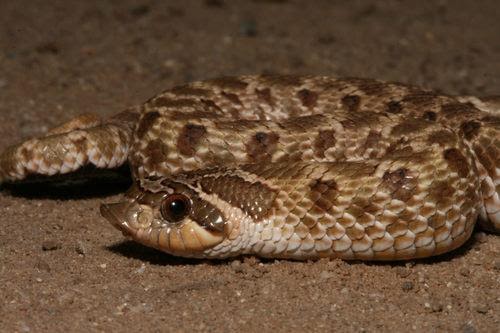
ID CARD
Name: The blow snake, also called Western Hognose Snake (Heterodon nasicus), is a snake from the Dispididae family. This family enlists most of grass-snakes that currently exist. This is exactly why we generally associate this snake to the Colubridae family. (The general scientific name of grass-snakes).
Habitat: The Western Hognose lives in a dry and sandy environment, from meadows to rocky surfaces dotted with a few shrubs. The species is endemic to North America. The western hognose snake also occurs from southern Canada throughout the United States to northern Mexico.
Size: This reptile is relatively small, its sizes ranges from 40 to 60 cm. However, large specimens (female) do exist, their size going up to 90 cm.
Way of life: Heterodon nasicus is a diurnal species, which means that it’s active during the day, especially during the twilight phases. In fact, it hunts mostly small amphibians as well as reptiles and rodents. The nose shape of this little snake is perfectly adapted to its food consumption because it uses its nose to dig in the sand, where the amphibians bury themselves during the day : The amphibians are then at the mercy of the Western Hognose.
This animal is characterized by its barely venomous minuscule fangs that sit at the back of its mouth. These fangs are very useful when it catches an amphibian. In fact, amphibians have the bad habit of inflating their entire body to stop predators from swallowing them. The venom of the hognose snake stops the swelling and slowly but surely, kills its prey.
For the species to reproduce, females spread a chemical substance once they shed their skin. Males can then find their partner by their scent.

INTERESTING FACTS ABOUT THIS ANIMAL TO USE WHILE FLIRTING … OR NOT
The Western Hognose Snake, just like the Eastern Hognose Snake, has a specific characteristic that makes him quite famous among serpents. While being a very small species, the Hognose snake has no defense mechanisms. Therefore, in order to survive when faced with a predator, the snake tends to bluff its way out.
There are different steps of bluffing depending on the degree of danger that the snake faces :
- Firstly, the reptile lightly flattens its ribs under its head to give the illusion of a cobra. That way, the snake seems more dangerous than it really is.
- Then the snake inhales to inflate its body and exhales strongly to let out all of the air in one go, which makes a very loud whistling sound. This phenomenon is called “puffing”. In addition to that, the snake also tends to pretend to want to bite the predator by propelling itself forward while keeping its mouth closed.
- Usually, such actions are sufficient to fool the predator (who then backs off). But if the predator doesn’t back off, the Hognose snake has one last trick up its sleeve : it starts convulsing as if it were dying dramatically, moving its head left and right, which makes the predator think that it is actually dying. And to perfect its act, the snake opens its mouth to let its tongue hang out and sometimes it even starts to bleed from the corner of its mouth and its anus.
- If it is overturned by the predator, it quickly rolls onto its back and if lifted, the body is fully relaxed and flabby. After a few minutes the actor lifts its head and if the danger has passed he gets back onto his stomach and leaves for shelter.
Written by Alizée Wagner
Translated by Nour El Ghazal
Sources :
- https://www.bio-scene.org/article/famille-des-colubrid%C3%A9s
- http://reptile-database.reptarium.cz/species?genus=Heterodon&species=nasicus&exact%5B0%5D=species
- http://www.desertmuseum.org/books/nhsd_hognose_snake.php
- https://animaldiversity.org/accounts/Heterodon_nasicus/
- Image reference : https://www.flickr.com/photos/53091040@N06/5373447917
- Illustration provided by Léa Prévost


Comments are closed